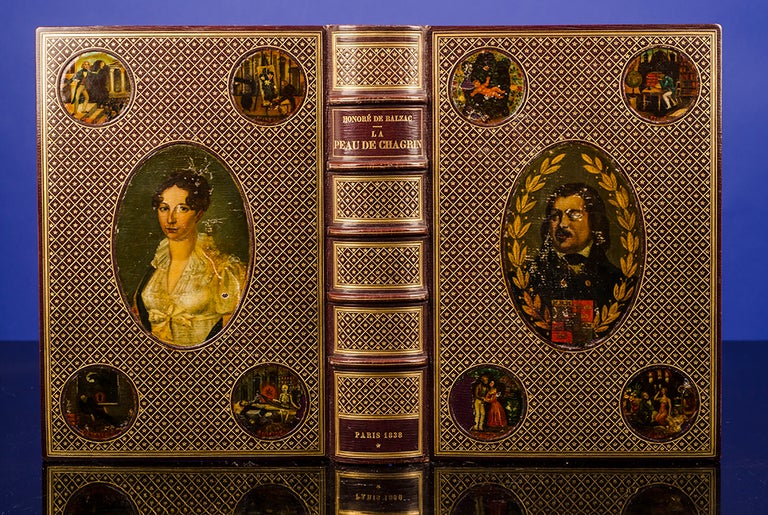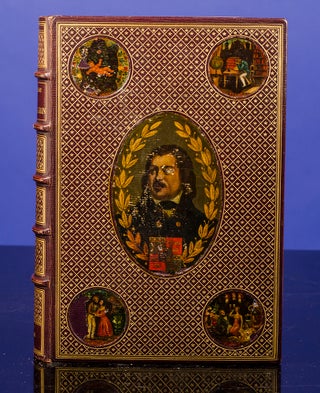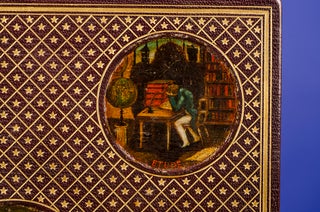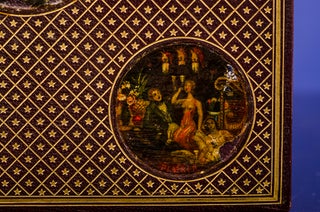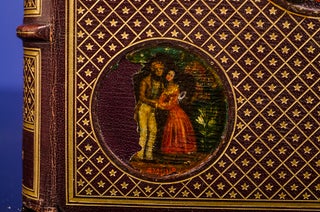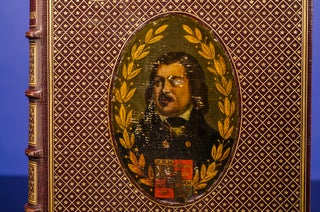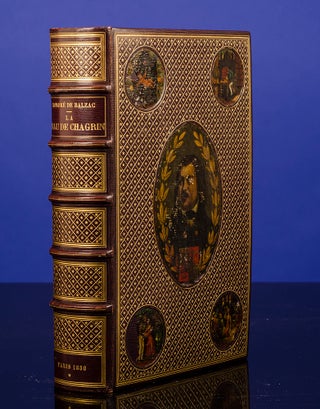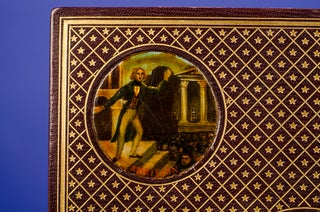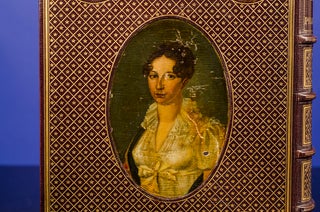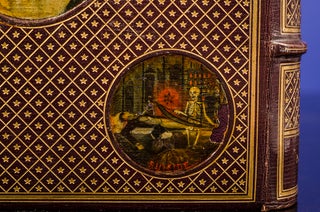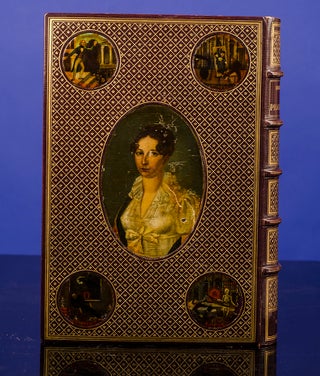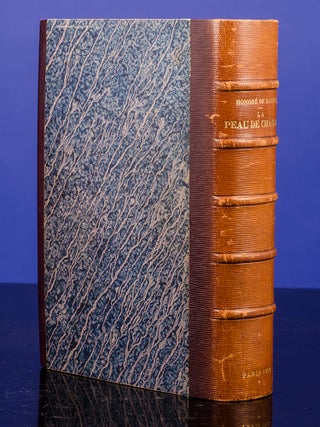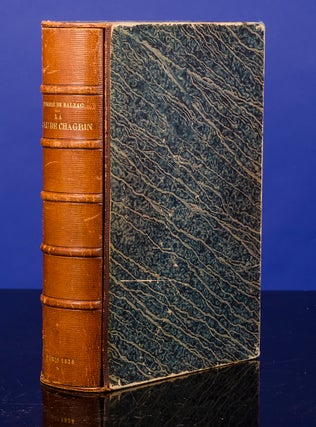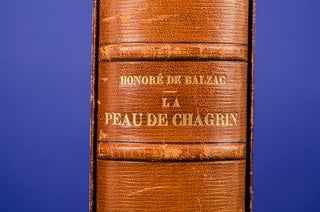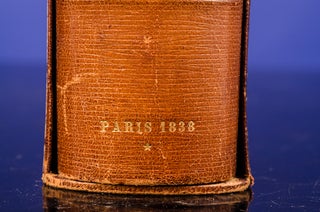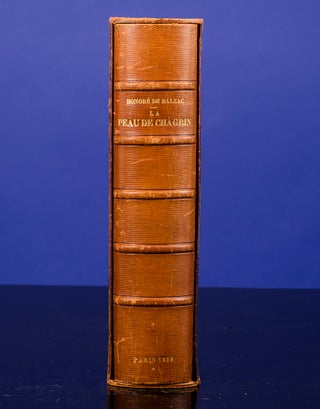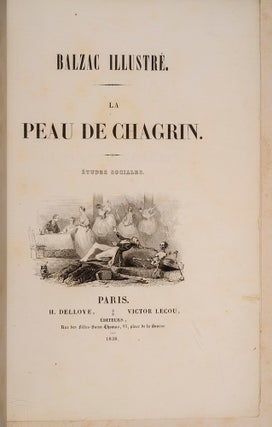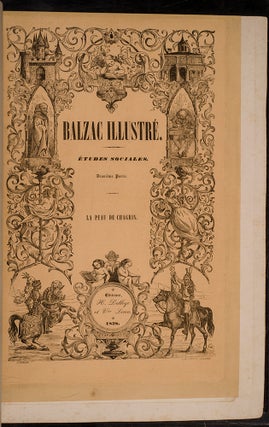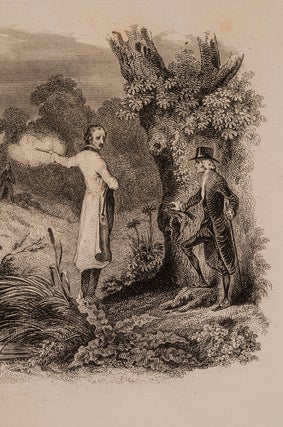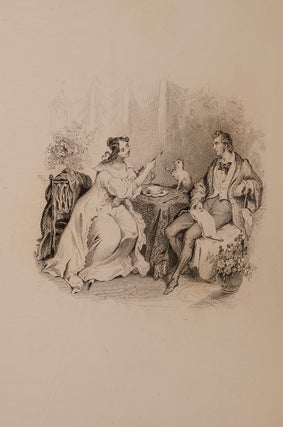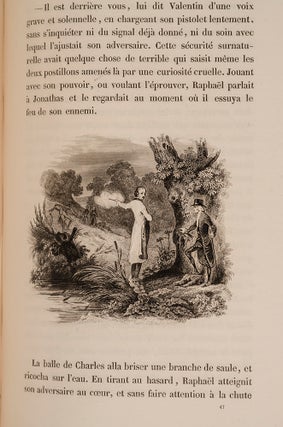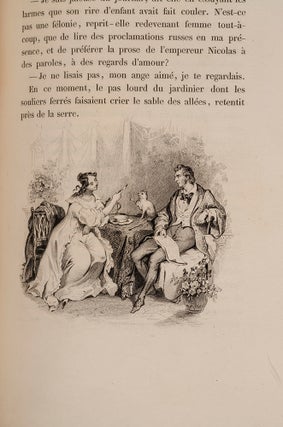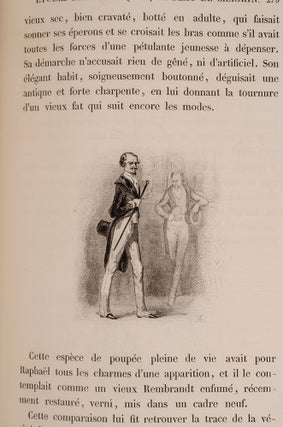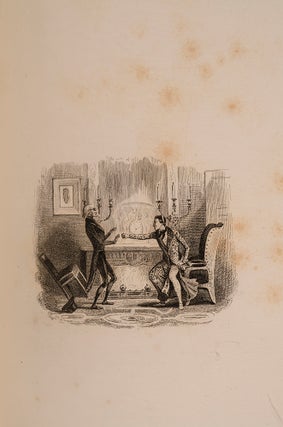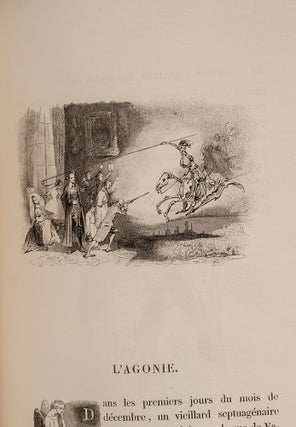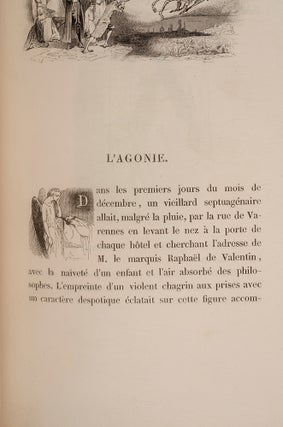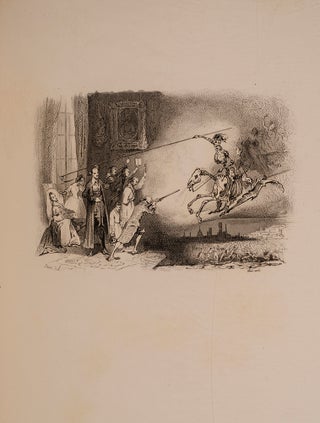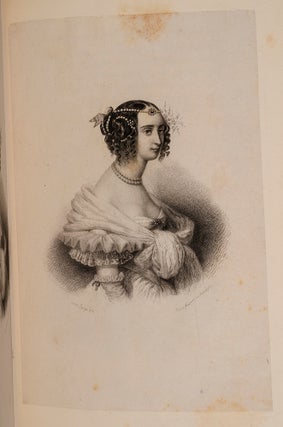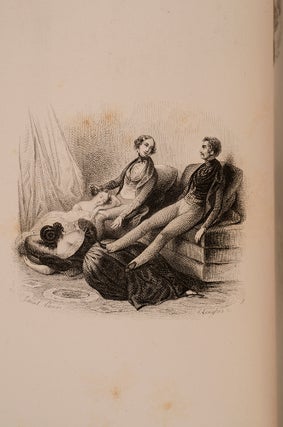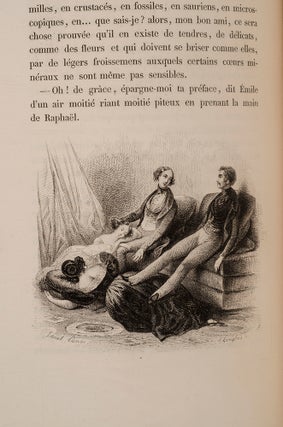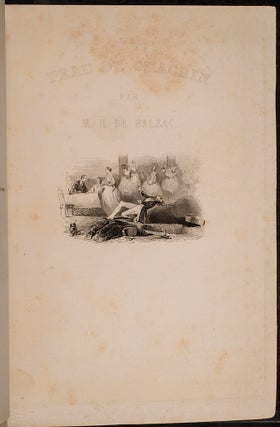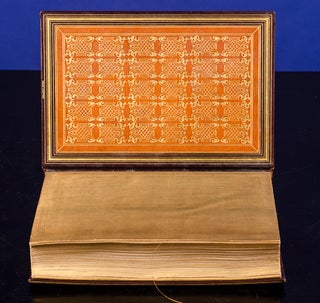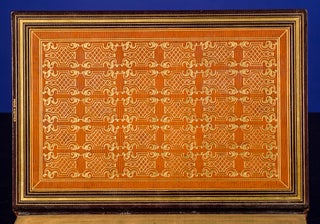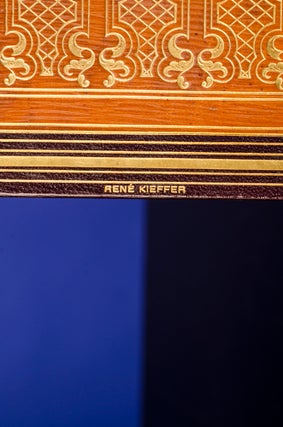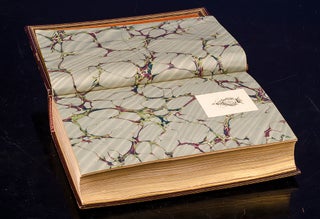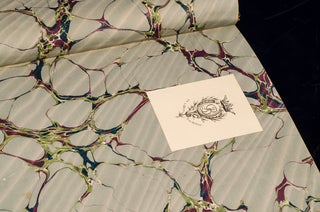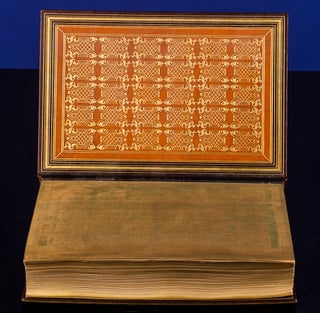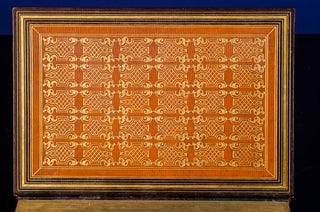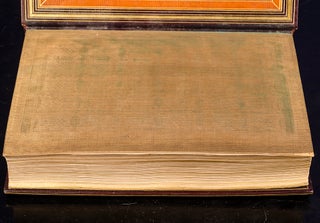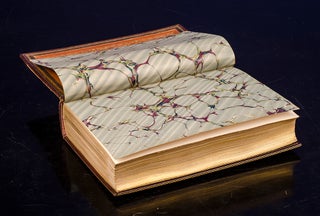Le Peau de Chagrin. Études Sociales.
Paris: H. Delloye [&] Victor Lecou, Éditeurs, 1838. Item #04605
An Incredible Early Twentieth Century 'Portrait' Binding by René Kieffer
Specially Bound for Gérard de Berny in Memory of his Father Gabriel de Berny
First Illustrated Edition with an additional set of Proof Illustrations on 'Large Thick Paper'
BALZAC, Honoré de. KIEFFER, René, binder. La Peau de Chagrin. Études Sociales. Paris: H. Delloye [&] Victor Lecou, Éditeurs, 1838.
First Illustrated Edition, First Printing of the Vignette Illustrations.
Specially bound by René Kieffer for Gérard de Berny in memory of his Parents.
'Thick Paper' copy with an additional 'proof' set of the illustrations.
Large octavo (11 1/16 x 7 1/2 inches; 281 x 191 mm.). [iv], 402, [1, Table des Matières], [1, blank]. One hundred and one decorative engraved vignettes in the text by Baron, Janet-Lange, Gavarni, French and Marckl, plus one on the title, engraved on steel by Brunellière, Nargeot, Langlois, etc. Additional engraved portrait on India paper of "Pauline", after Janet-Lange, engraved by Félicie Fournier, née Monsaldy (as appearing on pp. 149). Some foxing throughout, mainly marginal, otherwise fine.
An incredible early twentieth-century 'Portrait' binding by René Kieffer, stamp-signed in gilt on front turn-in and with his printed label on verso of front endpaper. Full brown morocco, covers triple-bordered in gilt enclosing a highly elaborate symmetrical gilt diamond design with gilt stars. The front cover inlaid with a large oval nineteenth century 'medallion' portrait in oil of Honoré de Balzac and four smaller circular nineteenth century 'medallion' oil paintings titled "Enfance" (childhood), "Etude" (study), "Amour" (love), and "Plaisir" (pleasure). The rear cover similarly inlaid with a large oval nineteenth century 'medallion' portrait in oil of Madame Louise Antoinette Laure de Berny (Balzac's first love "La Dilecta") and four smaller circular nineteenth century 'medallion' oil paintings titled "Ambition", Misère (misery), "Desespoir" (despair), and "Suicide". Spine with five raised bands, similarly decorated and lettered in gilt in compartments. Double-ruled gilt board-edges and multi-gilt ruled turn-ins surrounding an orange morocco liner, elaborately decorated in gilt in a symmetrical design, olive green watered silk endleaves, blue-gray marbled endpapers, all edges gilt. Original brown morocco over blue marbled boards chemise, housed in the original brown morocco edged blue marbled boards slipcase. Spine of chemise sunned, slipcase a little worn at extremities. The binding itself is near fine with just a few fragments missing from the edges of the 'medallions'. Original printed tan wrappers and spine bound in. Small square engraved bookplate of renowned collector, Gérard de Berny on front endpaper.
A stunning example reflecting the love affair between Honoré de Balzac and Gérard de Berny's mother, Laure de Berny. The nineteenth century 'Medallion' oil paintings are most certainly from the collection of Gabriel de Berny.
Roger Louis Gérard de Berny (1880-1957) was a French politician of the French Third Republic. He was born in Amiens, France. He was elected senator for the Somme in January 1936 and was one of those who voted to give full power to Marshal Pétain on 10 July 1940. de Berny did not return to government after the Second World War. He died in his Hôtel on Rue Victor Hugo in Amiens, now the Hôtel de Berny Museum. The Musée d'art local et d'histoire régionale or Musée de l'Hôtel de Berny is a local history museum for the region of Picardy. The Hôtel de Berny Museum includes 18th century tapestries and wood carvings, such as those from the La Fayette salon in the château de La Grange-Bléneau and those by the Huet brothers (Nicolas, François and Jean-Baptiste the Younger, the three sons of Jean-Baptiste Huet) and Adrien Choquet (a painter from Abbeville) from the Salon du Zodiaque in the Long château, as well as Art nouveau and Art déco ceramics by Montières, French Revolution-era faïence, paintings by Louis Jean François Lagrenée and Isabey, a 1612 harpsichord, pastels by Choderlos de Laclos and 16th-20th century ironwork and clocks. It also contains objects relating to figures from local and national history such as Gresset, Choderlos de Laclos, Jules Verne, Édouard Branly and Maréchal Leclerc.
Gérard de Berny's father, Charles Philippe Gabriel de Berny (1825-1884) was married to Laure de Berny, née Louise Antoinette Laure Hinner (1777-1836). "In 1793, aged only fifteen, Laure married Gabriel de Berny, but their union was unhappy. He was 20 years old, quite reserved and cold, whereas his young wife was very sensitive, warm-hearted and caring. Despite their differences, they still managed to have nine children, although five died in infancy and only two survived their mother. In 1815, the family bought a house in Villeparisis, in northern France, where they spent the summers. It was here that Laure first met Honore De Balzac. Laure was 42 at the time and already a grandmother, but this didn't stop the young Balzac (he was only 22) from falling in love with her. At first she resisted him, but Balzac wouldn't give up. He courted her for months and in the end, she gave in. The two become lovers. Of course nothing could remain secret for long in a small town. When Balzac's parents learned of it they tried to break off their scandalous relationship, but to no avail. Laure wasn't just Balzac's lover. She was his confidante, his muse and his benefactress. She gave him the love, security and confidence he hadn't received from his parents as a child, she supported his literary career (she inspired the characters of Madame de Mortsauf in The Lily In The Valley, and Pauline in Louis Lambert) and helped him out financially when he needed it. She assisted him in his business ventures, which always failed, and helped him pay his debts. "La Dilecta", as Balzac called her, also told him many stories about the ancient regime and of how some of her aristocratic friends and acquaintances managed to escape death during the Revolution, while others weren't so lucky. His royalist principles would be strongly confirmed by Laure's influence and it's from her he also acquired his aristocratic longings. Thanks to her help, he also managed to meet several influential people and would sometimes make an appearance in high society. Balzac would also talk to her about his relationship with other women, such as Madame de Hanska, who he would end up marrying a few months before his death. Laure De Berny died on 27th July 1836 at La Bouleaunière, her country house at Grez-sur-Loing. Balzac was in Italy at the time, but when he returned, he visited her grave." (historyandotherthoughts.blogspot.com).
René Kieffer (1875-1964) worked for ten years at the famed Chambolle-Duru bindery in Paris, specializing in gilding, before establishing his own workshop in 1903. He debuted at the 1903 Salon des Artistes Françcais, and, evolving toward to more modern approach, became a disciple of the great Marius-Michel. At the time of this binding's creation he had begun to incorporate a transitional mix of flowers, vines, and colorful onlays in rather formal compositions, their Art Nouveau motifs retained within symmetrical borders that revealed his classical roots. By the end of World War I he had emerged as one of Paris's leading binders, his work sought after by collectors, his fine workmanship matched by a wide range of progressive designs.
Before La Peau de Chagrin (first published in 1831) was completed, Balzac created excitement about it by publishing a series of articles and story fragments in several Parisian journals. Although he was five months late in delivering the manuscript, he succeeded in generating sufficient interest that the novel sold out instantly upon its publication. A second edition, which included a series of twelve other "philosophical tales", was released one month later. Although the novel uses fantastic elements, its main focus is a realistic portrayal of the excesses of nineteenth century Parisian bourgeois materialism. Balzac's renowned attention to detail is used to describe a gambling house, an antique shop, a royal banquet, and other locales. He also includes details from his own life as a struggling writer, placing the main character in a home similar to the one he occupied at the start of his literary career. The central theme of La Peau de Chagrin is the conflict between desire and longevity. The magic skin represents the owner's life-force, which is depleted through every expression of will, especially when it is employed for the acquisition of power. Ignoring a caution from the shopkeeper who offers him the skin, the protagonist greedily surrounds himself with wealth, only to find himself miserable and decrepit at the story's end. La Peau de Chagrin firmly established Balzac as a writer of significance in France. His social circle widened significantly, and he was sought eagerly by publishers for future projects. The book served as the catalyst for a series of letters he exchanged with a Polish baroness named Ewelina Ha ska, who later became his wife. It also inspired Giselher Klebe's opera Die tödlichen Wünsche.
Carteret, Volume III, p. 41.
Price: $9,500.00

 I have been in the rare and antiquarian book business for over forty years; my family has been in the rare books business since 1876. Rare books are in my blood.
I have been in the rare and antiquarian book business for over forty years; my family has been in the rare books business since 1876. Rare books are in my blood.
